Sep . 30, 2024 18:36 Back to list
Optimizing Efficiency in Tube Count for Heat Exchanger Design and Performance
Tube Count in Heat Exchangers Understanding Its Importance
Heat exchangers play a vital role in various industrial processes, facilitating the transfer of heat between two or more fluids without mixing them. The efficiency of a heat exchanger heavily depends on several design parameters, one of which is the tube count. The number of tubes in a heat exchanger significantly influences its performance, cost, and maintenance. This article explores the importance of tube count in heat exchangers and its impact on efficiency, design, and operational aspects.
Understanding Tube Count
The term tube count refers to the total number of tubes used in the construction of a heat exchanger. These tubes are typically arranged in a bundle and are responsible for carrying the fluids that exchange heat. In shell-and-tube heat exchangers, which are one of the most common types, the tube arrangement can be designed in various configurations to meet specific thermal and hydraulic requirements.
Impact on Heat Transfer Efficiency
One of the primary functions of a heat exchanger is to maximize heat transfer efficiency. A higher tube count generally increases the surface area available for heat exchange. This can enhance the overall heat transfer coefficient, contributing to more efficient thermal performance. However, increasing the number of tubes also results in a rise in fluid pressure drop across the heat exchanger, which can necessitate a more powerful pump or larger fans. Thus, a balance must be struck while a higher tube count can improve heat transfer, it can also lead to increased energy consumption.
Design Considerations
The design of a heat exchanger, particularly in terms of tube count, must take into account several factors, including
1. Fluid Characteristics The type of fluids involved, their flow rates, and properties such as viscosity and density significantly affect the tube count. For instance, fluids with higher viscosity may require a different tube design to ensure effective heat transfer.
tube count heat exchanger

2. Application Requirements Different industries have varying heat transfer needs. A power plant may require a heat exchanger with a larger tube count to handle high thermal loads, whereas a food processing plant might prioritize hygiene and ease of cleaning.
3. Space Constraints The available space for installing a heat exchanger can limit the design options. Engineers often must balance the need for a higher tube count with physical space limitations, leading to creative design solutions such as using longer tubes or special arrangements.
4. Cost Implications More tubes mean a higher material cost and increased complexity in manufacturing. Additionally, a higher tube count may lead to increased maintenance requirements due to fouling, necessitating regular cleaning and inspection.
Maintenance and Operational Challenges
While a higher tube count can improve thermal efficiency, it also introduces challenges in maintenance. More tubes can lead to greater opportunities for fouling, which can impair efficiency and increase energy consumption. Maintenance teams must develop strategies to regularly clean and inspect the tubes, ensuring that the heat exchanger operates at optimal performance.
Moreover, operational costs must be considered. As the number of tubes increases, the pumping energy required to circulate the fluids can also increase, impacting overall operational efficiency. Conducting a thorough economic analysis during the design phase can help to quantify these costs in relation to potential thermal efficiency gains.
Conclusion
In summary, the tube count in heat exchangers is a critical factor that influences thermal efficiency, design, and operational effectiveness. While increasing the number of tubes can enhance heat transfer, it also presents challenges such as increased costs and maintenance. Engineers and designers must carefully consider these factors when optimizing heat exchanger performance for specific applications. By finding the right balance, industries can ensure that their heat exchangers operate efficiently, meeting the demands of modern processes while minimizing energy consumption and operational costs.
-
Durable Cast Steel Concrete Pipe Mold Bottom Rings & Base Trays
NewsAug.23,2025
-
Centrifugally Cast Iron Water Main Pipe for Reliable Mains
NewsAug.22,2025
-
Durable Centrifugally Cast Iron Water Main Pipe
NewsAug.11,2025
-
Centrifugally Cast Iron Water Main Pipes for Reliability
NewsAug.10,2025
-
High-Quality Centrifugally Cast Iron Water Main Pipes
NewsAug.09,2025
-
Durable Cast Iron Water Main Pipe & Drainage Solutions
NewsAug.08,2025


